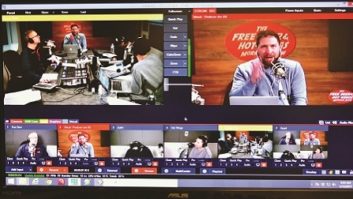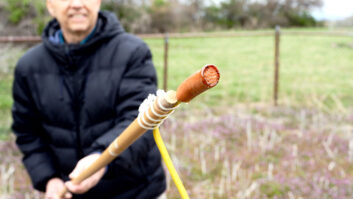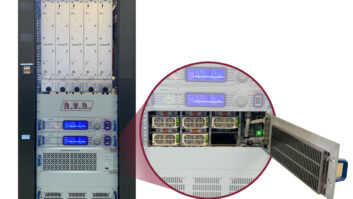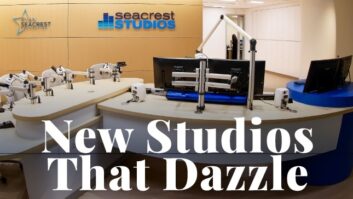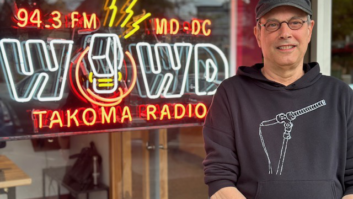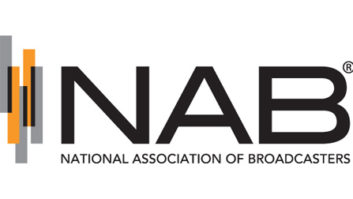�Free Beer� and �Hot Wings� in the Morning
Sep 1, 2014 10:31 PM, Mike Maciejewski, Chief Engineer, WGRD-FM, Grand Rapids, MI

Action films don”t begin to compare to the stunts that the morning team pulls off every day putting together �The Free Beer & Hot Wings Morning Show� for radio syndication, a television segment, a smattering of podcasts and video, and whatever else the team comes up with. The new studio includes an LX-24 control surface with TS-4 Talent Stations networked through a WheatNet-IP audio system.
There”s a reason why we call one of our audio producers the stunt boy�and it”s not just because he does wild stunts like drive cross-country to the Lindsay Lohan trial so he can be the crazy guy in the pink shirt jumping up and down on the evening news, or flying to Pamplona, Spain to �run with the bulls.�
Producer Joe Gassman and the morning show team jump through hoops to produce the Compass Media syndicated �The Free Beer & Hot Wings Morning Show� out of Townsquare Media”s WGRD-FM studios in Grand Rapids, Michigan.
On any given morning, there are any variety of entertainment clips to source from the Internet, podcasts to upload on the fly for the website, live video streams over the Internet headed for the studio, the website, or both, and iPhones with cameras recording every move.
There”s also the small matter of a 6 a.m. segment with the local ABC TV affiliate, which is broadcast live at the same time the morning team syndicates its radio show to some 43 markets spanning the continent, from Portland, Maine, to Palm Springs, California.
All of this comes with the kind of stunts you”d expect of a live action film, but with none of the CGI.

The show”s cast and crew�Gregg �Free Beer� Daniels, Chris �Hot Wings� Michaels, Eric Zane, along with producers Joe Gassman and Steve McKiernan, had been complaining for some time that we needed a studio that was more modern. For 10 years we made changes here and there in the old analog studio to keep up with the show, its expanding syndication, and an increasingly competitive media environment. Eventually, however, it was obvious that we needed a radical change to keep up with it all.
The real eye-opener occurred when the morning cast and crew sat down as guests at an affiliate”s broadcast studio, and noticed how easy it was to integrate all of their laptops, tablets, and iPhones into the studio. The affiliate station was using IP audio networking.
We wanted a similar set up, and were surprised to learn that it was all very doable. Ten years ago when the show became syndicated, audio over IP was a pipe dream for us; something that only major-market stations could afford. Now, not only could we afford it, but it was becoming increasingly obvious that we could no longer afford NOT to upgrade. We could no longer expect the old analog studio to handle it all. The show began doing monthly live remotes from affiliate markets which required additional mix-minus capability beyond the two that the existing analog console could handle. But by the time we added the television segment, things got interesting. The morning team was syndicating the radio program live to all of our markets, doing a local break for flagship WGRD, while at the same time doing the segment on the ABC TV affiliate in Grand Rapids. Timing wise, it is quite a juggling act, and interesting to see the guys pull it off so smoothly every day.
continued on page 2
�Free Beer� and �Hot Wings� in the Morning
Sep 1, 2014 10:31 PM, Mike Maciejewski, Chief Engineer, WGRD-FM, Grand Rapids, MI
Finally, in July of 2014, it happened. We modernized the �Free Beer & Hot Wings� studio entirely, moving up to our fifth Wheatstone console, the LX-24, with two TS-4 Talent Stations for the producer booths. The studio is networked using WheatNet-IP with eight audio I/O and processing blades. The team can handle just about any workflow situation that arises, and there are plenty of new situations that happen daily!
Immediately, the LX-24 solved the pressing problem of coordinating the TV segment with the affiliate stations and the local breaks in the show. The entire setup for this segment of the show is stored as events in the LX-24 control surface and activated with the push of a button, along with the source and destination groupings. In the old studio, the team had to switch the mic settings from the night before and setup any sources they might need. With the LX-24, these transitions are easily executed with a simple button press.
Next on our list was to integrate the two producers more into the workflow. Two TS-4 Talent Stations took the place of a basic panel with mic and talkback buttons and an amplifier that was hard-wired to the studio monitor output from the control room. That was a problem because the producers couldn”t monitor other sources. They were operating blind in many cases, with no ability to spot check the network feed. Now, if there are issues with the satellite during the show, for example, they”ll be able to dial around on the TS-4 to make sure that it”s there.
The look of the studio is critical these days, since the show produces a lot of live video for our website as well as still shots for social media including Instagram and Facebook. The show”s website presence alone is impressive. There are several thousand paying subscribers to the website, so it”s important to keep these fans engaged not only with sound, but with video as well.
For this new multimedia world where looks are as important as sound, the first thing we eliminated in the new studio was the clutter of computer monitors and keyboards that crowd the countertops. There are a large pair of LCD screens on the wall for automation, another one for the web, and yet another for the call screener. Because Hot Wings and Eric sit across from Free Beer, we mirror the automation and web screens to displays on the opposite wall so they can see them as well. We had collected way too many computer monitors over the past 10 years, and ended up with a very cluttered and crowded workspace.
The clutter has been eliminated. In the new studio, we still have seven monitors, but they have been replaced by the 40-inch LCD screens on the walls. Putting the monitors on the wall cleared the sight lines between the talent and gives the studio a much more natural setting for the guys to fight with each other. The new low profile �TV� mic arms from Yellowtec nicely eliminated the cluttered look of traditional overhead mic booms.

With seven large LCD monitors, we needed a way to manage the video displayed on them. A Kramer 8×8 video matrix router gives us the capability to choose which computer is displayed on each LCD. We can also dynamically change this on the fly using automation triggers thru the Wheatnet blade logic ports. An example would be switching the mirrored screen from showing Nexgen during a spot break back to the call screener display during a show segment.

The show had been streaming live video to their website for about 4 years using a couple of simple consumer webcams. In the new studio we”ve upgraded to a professional HD multi-camera setup and will be producing the show like a conventional TV talk show. We”re using vMix, a software based video switcher running on a custom PC that has the horsepower to handle the task. It performs switching, graphics, stream encoding, and can also record the program. The camera switching is automated to have the video follow audio using a custom Arduino micro controller. The Arduino runs a script that I wrote for making intelligent switching decisions based on which mics are active. If, for example, two of the guys are arguing, it can bring up a side by side shot of those two cameras. Or if the entire crew is laughing together it can bring up a group shot. The Arduino controller is connected to the Wheatstone M4 blade audio and logic outputs.

We did a lot of research before choosing video cameras. We needed something that wasn”t beyond the reach of our budget. Webcams were quickly ruled out for the close-up shots, though we”re still using a few for the wide shots of the studio and in the producer booths. We needed cameras that have a zoom lens so the close-up shots could be properly framed. This way the audience will really be able to see facial expression and reactions, adding an entirely new dimension to the viewing experience. We looked at consumer grade camcorders as one possible solution, but the HDMI cabling is troublesome to extend. We ended up choosing the Marshall Electronics 1080p HD-SDI cameras which use basic 75 ohm coax cabling and work well with the 60 foot run to the vMix PC. Total cost for the entire video system including cameras, software, and computer was less than $8,000. This is a fraction of what gear of equivalent quality would have cost just a few years ago.
�Free Beer� and �Hot Wings� in the Morning
Sep 1, 2014 10:31 PM, Mike Maciejewski, Chief Engineer, WGRD-FM, Grand Rapids, MI
Sound is Important
It”s not just about looks with the new studio. The guys use quite a few YouTube clips, They”ll play news clips of odd stories and comment on them; rewinding, mixing, and adding a few zingers as they go. Quite often this spins into discussion with listeners calling into the show.
These clips can vary considerably in audio quality. To clean up the sound, we are now able to use the processing in the LX-24”s mix engine. This built-in audio processing help us manage some of the wild levels and EQ to improve quality.
Listening to the show, it seems like they”re winging it, but in truth they do a lot of prep in advance. Our new studio now lets them focus on what they do best!
Equipment List
Audio:
�
- – Wheatstone LX-24 console
- – M4 mic processors
- – Aura8ip
- – ip88ad and ip88cbe blades
- – Yellowtec Mika TV mic arms
- – Heil PR-40 mics
- – Custom furniture from Omnirax
�
Video:
�
- – Custom-built PC for video switching
- – �vMix HD� software video mixer
- – Black Magic Design Decklink Quad HD-SDI capture card
- – Marshall Electronics CV340CSB HD-SDI cameras
- – Custom Arduino controller for video follow audio switching
- – Kramer VP-8×8 matrix video switcher
- – Leprecon DMX controller
- – Elation TVL1000II LED studio lights
- – Lighting design, rigging and installation by LiveSpace
�
@ www.lsavl.com





